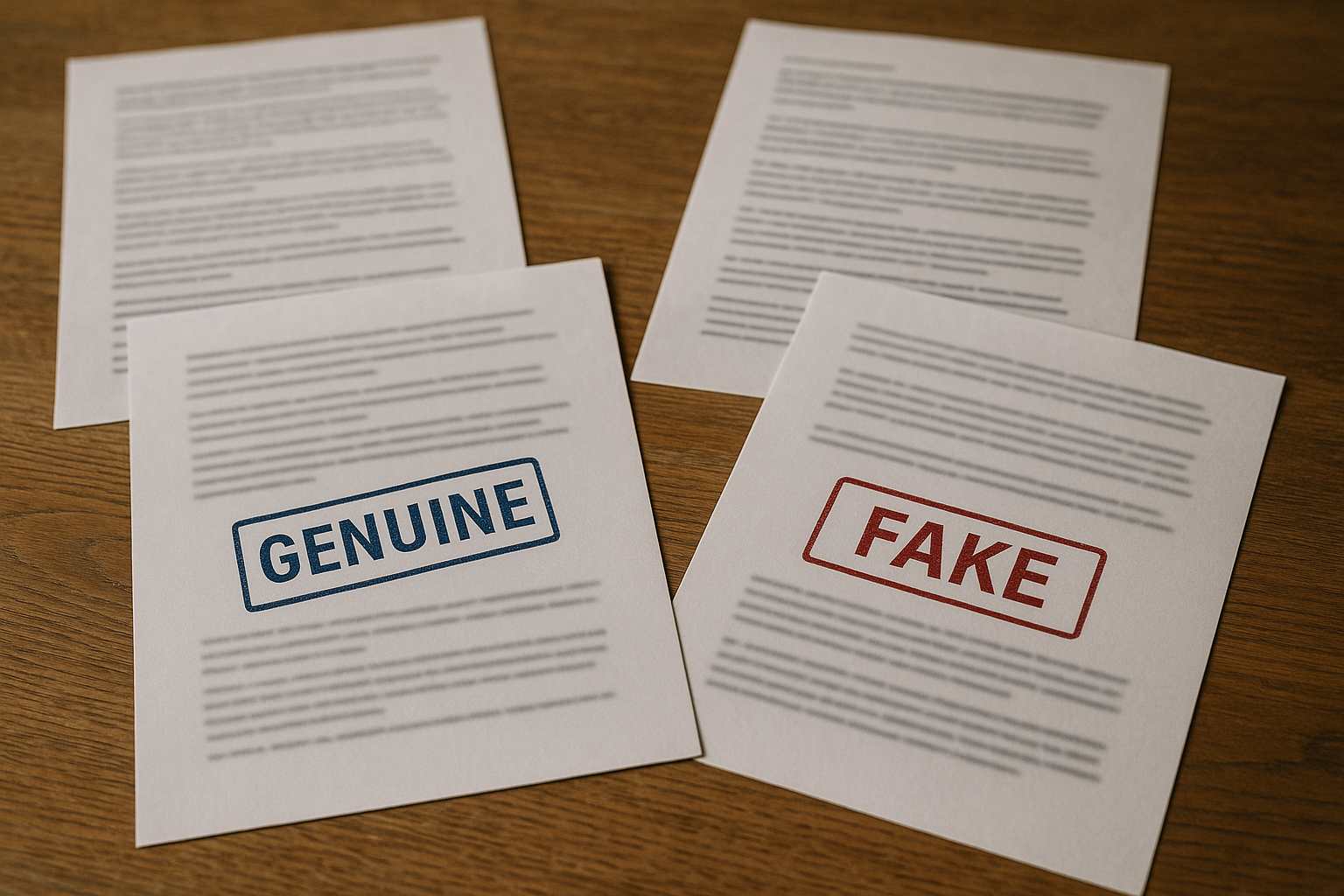9000+ Cashless Garages
96% Claims Settled (FY 24-25)

9000+ Cashless Garages
96% Claims Settled (FY 24-25)



While online transactions have become the rule today, fraudsters have trapped innocent bike owners by selling fake replica bike insurance policies. Being lured into buying a fake policy by mistake could lead to legal trouble, money loss, and no-claims settlements in the event of an unplanned incident. Hence, checking your policy's authenticity is a must.
This article provides valuable tips for identifying a fake or real bike insurance policy and illustrates how to verify its authenticity.


A fictitious bike insurance policy may bring you various forms of legal and financial trouble. To dupe genuine buyers, scammers employ various tricks, but certain indications will highlight a fake policy. The following are the signs that most commonly appear when there is a fake bike insurance policy:
An exorbitantly low premium is one of the most striking signs of a clone bike insurance policy. Scammers try to entice unsuspecting buyers with low prices for policies or by presenting too-good-to-be-true deals. Genuine insurance firms abide by IRDAI pricing norms. They provide premiums depending on the policy category, bike model, and claims record.
If the policy costs much less than the rest of the market, its authenticity must be confirmed before purchase.
One can always check through the website, mobile application, or the insurer's Insurance Information Bureau (IIB) portal if the policy is genuine. If the information is not found on the insurer's database or there has been miscommunication, then one can be certain that the policy is not authentic.
Actual policies also have an IRDAI-approved QR code, which can be scanned and verified instantly.
Spurious policies usually come with inefficiently designed policy documents containing multiple mistakes. They might contain incorrect spellings of words, irrelevant stamps of the insurer, or absent policy details. They even have inferior-quality prints. The proper policy document is printed on the insurer's official letterhead.
Check the details, such as coverage, policyholder's name, and terms and conditions. If a document appears unprofessional or does not contain important details, check it with the insurer.
One of the red flags of an insurance fraud policy is that there is no process for claim settlement. A real insurer has an established procedure for claims by policyholders, such as how to make a claim, what forms to fill out, and what rough estimates of the time of settlement. Imposter insurers provide unclear and variable answers about the procedure.
If the insurer is not forthcoming in describing the claims process or does not reply promptly when questioned, this could be a sign of fraud.
Most fake policies are sold by unauthorised agents, clone websites, or unknown third-party vendors. The original policy is purchased only from the insurer’s website, a trusted insurance aggregator, or an approved authorising agent. Scam marketers may use misleading promotions or unofficial payment channels to avoid scrutiny.
If the seller or agent cannot show proof of authorisation or represents an unregistered insurer, it is best not to buy the policy from them.
With the prevalence of fake bike insurance nowadays, one must verify such insurance. There are many ways, online and offline, to check whether it is the real deal. You may go through the regulatory website, scan the QR codes, or contact the insurer directly. It is important to verify your policy to stay safe and secure.
One must verify the bike insurance policy before they get duped for their time and money. The table below describes some of the online methods through which one could easily and reliably verify the authenticity of the bike insurance:
Offline verification of your bike insurance policy assures authenticity and doesn't involve dishonesty. Below is a table that provides effective offline methods of confirmation:
A genuine bike insurance policy ensures financial security and hassle-free claims. With the rise in fraudulent policies, it is necessary to buy from trusted sources. Below are several of the safest ways to buy a legitimate bike insurance policy and avoid potential fraud:
The best and safest method of buying a true bike insurance policy is from the insurance company's official website or by going to their branch office. While buying online, ensure that the website URL is proper and secure (it should include "https://" in the address bar). Never click on links from third-party advertisements or unknown sources.
Web insurance comparison websites help customers compare and buy policies from authentic insurers. They feature only policies from IRDA-approved insurers. This reduces the chances of fraud. Review the terms, coverage details, and premium amounts carefully. Make sure they match your expectations before purchasing.
Check his credentials if you prefer buying your policy from an insurance agent. Every licensed insurance agent is registered on IRDAI. Cross-check their registration details with the IRDAI website or request their authorised proof before buying. Be suspicious of agents requesting cash payments or handing over the policy documents instead of anything else.
Before selecting your insurance company, review customer reviews and ratings. Check Google Reviews, Trustpilot, and consumer forums. Legitimate insurers have positive reviews and a good market reputation. They also have a solid claim settlement track record. Avoid insurers with continuous complaints of fraud, claim denial, or non-responsive customer service.
If you find that your bike insurance is fake, take immediate action. Here are certain key steps that you should take:
If your bike insurance policy is fraudulent, report it to the Insurance Regulatory and Development Authority of India (IRDAI). This should be your first action. You may file your complaint by emailing complaints@irdai.gov.in or writing to their grievance helpline at 155255.
If you bought the policy from a questionable agent, inform the insurer. If the source was unauthorised, notify the original insurer immediately. They will verify if the policy is counterfeit and instruct you on further action. A few insurers even assist in tracking down counterfeit agents or issuing an authentic policy.
Insurance fraud is a serious crime, and informing the police about it is vital for taking legal action. Go to the closest police station and register a First Information Report (FIR) against the imposter. To strengthen your case, share all supporting evidence. This includes forged policy information, payment vouchers, and conversation records.
If you used a bank transfer or credit card, please verify your transaction records. Report fraud to your bank, as some banks have fraud protection services. They can reclaim the amount and investigate unauthorised payments on your behalf.